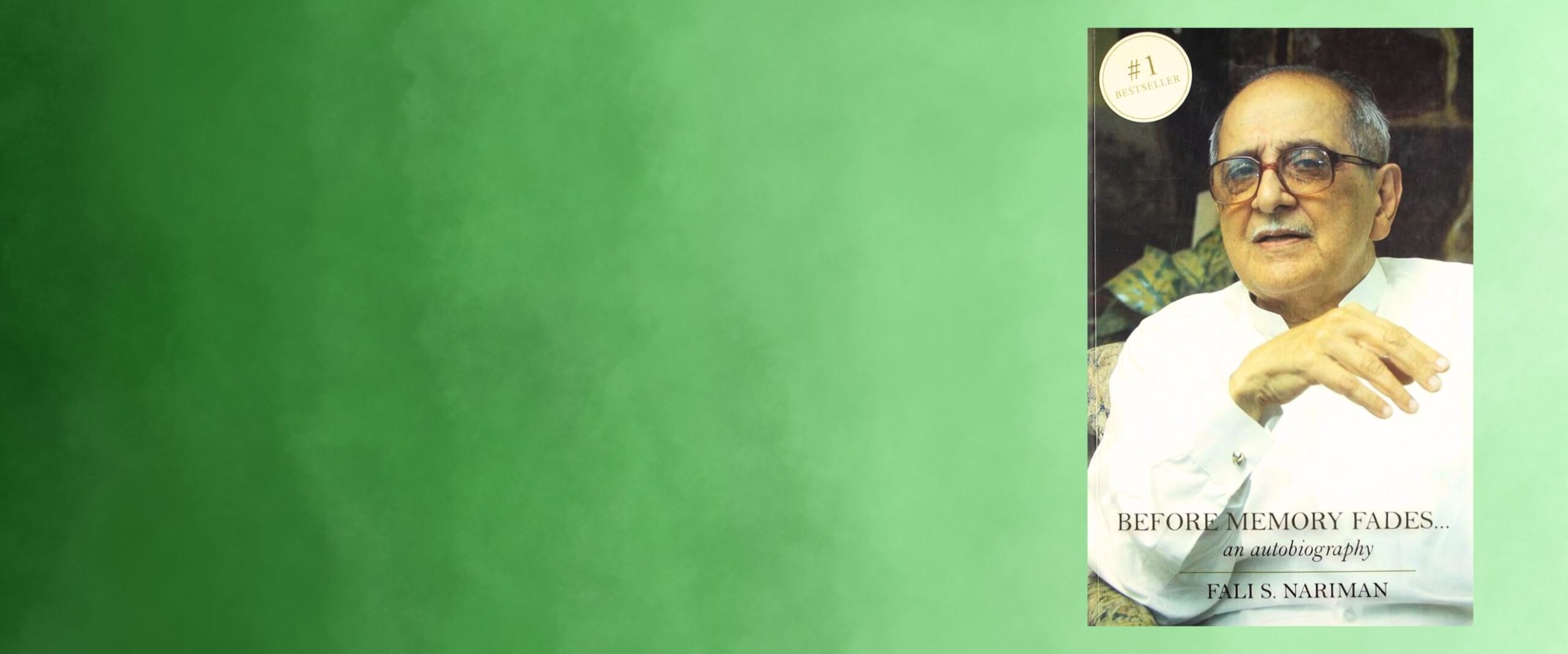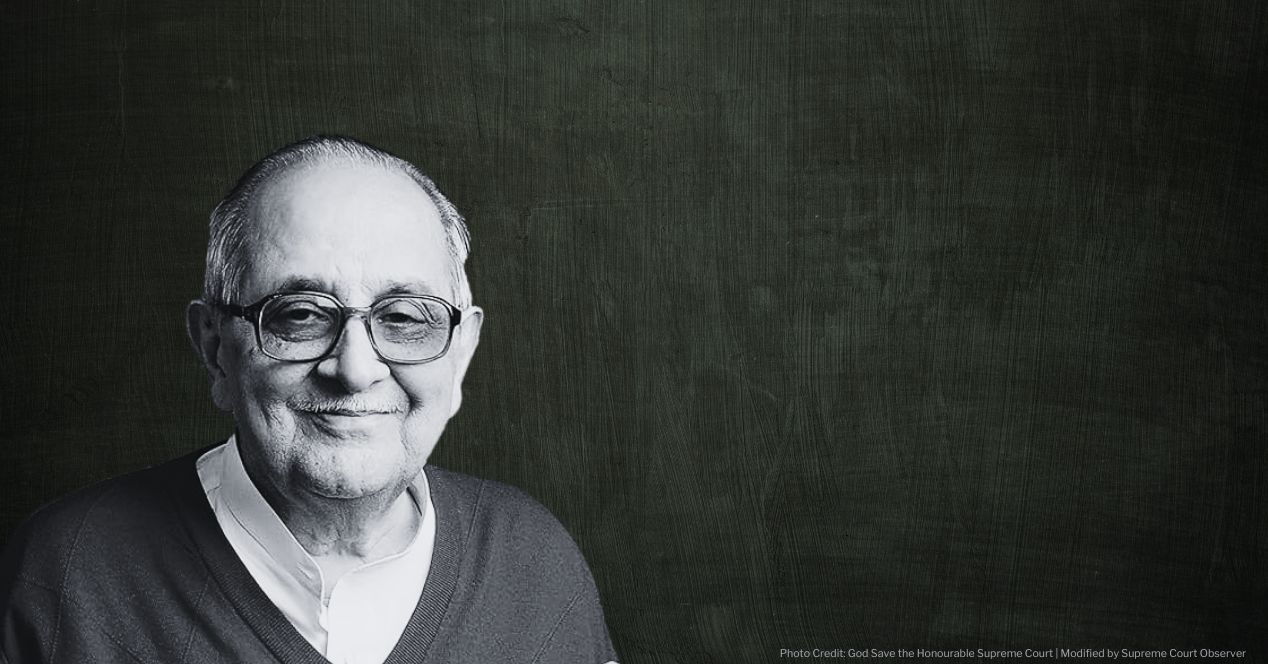Analysis
A star in the judicial firmament: Fali Nariman on Justice Subba Rao
An excerpt from Nariman’s autobiography showcases his wit and insight on a favourite topic: Supreme Court judges

I think I can claim to have appeared before all (or almost all) judges who have sat in the highest court since 1 May 1972 (the day I moved to Delhi), and a few of them (like Justice Subba Rao and Justice Hidayatullah) even before, on some infrequent appearances in the Supreme Court. I consider myself singularly fortunate to have known what I would describe as the Subba Rao era, and to have lived through the Krishna Iyer era for they were important turning points in my career. I can unhesitatingly say that I am a better constitutional lawyer for having lived through these two great periods of our legal history.
In the course of my long professional career I have appeared before judges – of the high courts and of the Supreme Court – some of them excellent, some good, some not so good, some pompous, some courteous, some wooden-headed.
About the wooden-headed I recall what Vishwanath Sastri, a lawyer who had a most fertile and receptive mind, once told me… His mind was a storehouse of legal knowledge, and his conferences (like the conferences of Jamshedji Kanga) never lasted for more than 30 minutes. At one such conference in a somewhat relaxed mood, Vishwanath Sastri asked me in his simplistic sing-song voice, ‘Ah – you are from Maharashtra. I appeared the other day in the Allahabad High Court before a judge from your state …’ at which I politely asked him, ‘And what did you think of him Sir?’ And he shook his head and quite innocently said, ‘Ah – nothing entered his head.’ This may or may not have been true but it was Vishwanath Sastri’s description of the judge’s mental capacity which always made me sceptical, from then on, of judgments of that particular judge!
…. Let me say quite seriously that (since 1950) there have been three types of judges who have occupied places in the highest judiciary of this country. First, judges with a political agenda. Second, judges with a social agenda. And third, judges without an agenda. I consider it significant for the development of the law that judges in the third category have been the most numerous. The reason is the same as that given (long ago) by an English judge when speaking about Lord Denning. He likened Denning to a great Oak tree, and then added that the reason why his country was so proud of him was because it simply would not do to have too many of them! If all judges of the Supreme Court of India had a political agenda and gave vent to their views (as Justice Subba Rao did) or if all the judges of our apex court had a social agenda and fashioned their judgments accordingly (as Justice Krishna Iyer did), there would have been a massive public outcry…. But it is because judges with an agenda are few in number that they are long remembered.
….In the judicial firmament during these past 50 odd years, there have been many bright and brilliant stars…But the pointers – the pathfinders – have been a handful and I can name only two – Justice K. Subba Rao and Justice V. R. Krishna Iyer…
When Professor Arthur Goodhart died in 1975, completing 50 years as editor of the Law Quarterly Review, Lord Diplock wrote of the enormous influence he had on those who had comprised so large a part of the higher judiciary of England. Lord Diplock said that Professor Goodhart had, over the years, ‘altered the habits of the mind of judges’. The practice of the law in India with its reliance upon precedent had, in the first decade of the Supreme Court, induced an ingrained resistance to change, not least amongst those who practised the law long enough to attain the highest judicial office. K. Subba Rao and V. R. Krishna Iyer were different. They are two outstanding examples of judges who in different ways influenced and altered ‘the habits of the mind of judges’ – the judges of the 1960s, 1970s and 1980s.
The influence of Subba Rao began with his appointment as a judge of the Supreme Court in January 1958, though paradoxically, as a puisne (junior) judge of the court, he was also its most frequent dissenter. The Subba Rao era began with his short but vigorous tenure as chief justice from 29 June 1966 till 11 April 1967, when he resigned to contest (unsuccessfully) for the office of the president of India. Presiding over the Constitution Bench in that brief period of ten months as chief justice, decisions in as many as 62 different cases were handed down, almost all important constitutional cases. Sixty of the 62 judgments delivered by the Constitution Bench presided over by Subba Rao in that brief ten-month period were unanimous decisions – a rare example of firm judicial leadership.
….
Those who sat with him have frankly confessed that they were not only impressed by his ability and intellect, but they were also greatly moved by his innate courtesy and his keenness to persuade. The impetus for change after all depends on the personal persuasion of someone who is accepted as a respected colleague. That influence can never be lasting if it is obtrusive. Persuasion is more successful when it creates a mental atmosphere receptive to change. Subba Rao created that atmosphere (as did Chief Justice Venkatachaliah much later – February 1993 to October 1994).
Chief Justice S. R. Das, on his retirement in September 1959, made an amusing farewell speech which was published in the law reports. About ‘Brother Subba Rao he was particularly jocular – (after referring to some of his other colleagues in a lighter vein) he went on:
Then we have Brother Subba Rao who is extremely unhappy because all other fundamental rights are going to the dogs on account of some misconceived judgments of his colleagues which require reconsideration.
The serious bit in this piece of frivolity was that Brother Subba Rao did sincerely believe in what he was later to describe as the ‘transcendental nature’ of fundamental rights. He genuinely believed that many decisions interpreting various provisions in Part III of the Constitution in the first decade of the Supreme Court were retrograde. In his seven years on the bench, more than six of them as a puisne judge, he did his utmost to undo them. In the early years when he couldn’t, he dissented. In later years, when he could muster a majority for his views, he gladly affirmed his previous dissents which then became the law of the land!
In all spheres of the law, particularly in matters pertaining to constitutional law, he was the one who was the most articulate. He was rarely content with joining in the majority opinion – even when he concurred with the majority he expressed his view. The number of his concurring opinions was well above the norm. He wrote the largest number of dissents – judgments in as many as 49 different cases dissenting from the majority. Contrast this with six justices of his time who never wrote a single dissent, and another six, each of whom only contributed a single dissent!…
In the Kharak Singh case – which dealt with a police regulation authorizing domiciliary nocturnal visits to the houses of alleged disreputable characters – he showed the way for the first time for a broader interpretation of Article 21 of the Constitution. ‘The petition,’ he said, ‘raises a question of far-reaching importance – the right of every citizen of India to lead a free life subject to social control imposed by valid law.’ He was not deflected (as was the majority) by the fact that the question had been raised at the instance of an alleged disreputable character (Kharak Singh had a long criminal history-sheet). ‘If the police could do what they did to the petitioner,’ said Subba Rao, ‘they could also do same to an honest and law-abiding citizen.’ He held that the expression ‘life’ in Article 21 could not be confined only to the prohibition against the taking away of life. ‘It inhibits against its deprivation,’ he said, ‘but it is also extended to all of those limbs and faculties by which life is enjoyed.’ Mark you, ‘faculties by which life is enjoyed’ heralding and anticipating the later liberal sweep of Article 21 as interpreted in the Krishna Iyer era; so with the word ‘Liberty’, also in Article 21. The right to personal liberty is not only a right to be free from restrictions placed on a citizen’s movements, (he said) it also encompasses freedom from encroachment on his private life.
It was argued for the state that the fundamental right to freedom of movement meant only that a person could move physically from one point to another without any restraint. Justice Subba Rao rejected this as unacceptable in a free society…
…Years later, long after Subba Rao ceased to be on the court, a bench of three judges (Justice Mathew, Justice Krishna Iyer and Justice Goswami) inspired by this dissent held in Gobind vs State of M. P. that there could be no doubt that the makers of our Constitution wanted to ensure to its citizens conditions favourable to the pursuit of happiness and that they must be deemed to have conferred upon the individual (as against the government) a sphere where the individual should be let alone. The dissent in Kharak Singh had pointed the way…
A special thank you to Hay House Publishers India for permission to run this excerpt from Fali Nariman’s autobiography titled Before Memory Fades. You can purchase the book here.




